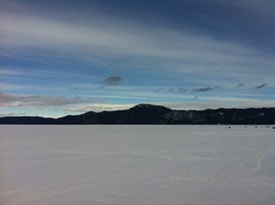Barbara Latkowski
Caledonia Courier
In Fort St. James, this winter may seem unusually mild, warm and even considered balmy.
It’s not like previous winters according to those who have grown up in the Fort.
From Murray Ridge Ski Hill facing unpredictable conditions and cancellations to logging trucks having to change schedules, this winter season is proving to be not really much of a winter at all.
Some might prefer the warmer weather.
But for many in the Fort, they are accustomed to a winter with minus 30 temperatures being the norm and Stuart Lake freezing over by November. Typically, this is what’s expected in Fort St. James.
But, with above zero temperatures being the norm this year, what can be expected this spring in the Fort?
According to AccuWeather Global Weather Centre, spring of 2016 may rank in the top 10 warmest on record for Canada as a whole.
The season is expected to have an early start across much of the country due to El Nino’s influence.
El Nino is defined by above-normal ocean water temperatures in the central and eastern Pacific, near the equator. As a result, Canada is set to experience warmer-than-usual spring weather.
AccuWeather says this will be the case for much of Canada this year with the exception of areas from northern Quebec through to Labrador. Colder weather will develop due to a prevailing northwesterly flow of cold air originating over the ice-covered Hudson Bay.
In Western Canada, a persistent area of high pressure will keep much of the region, including Calgary and Edmonton, drier than usual and the main storm track will detour north into Alaska.
A lack of snow cover across the Southwestern Prairie region is set to accelerate the warmup for cities like Regina and Saskatoon this spring.
Despite drier and warmer weather, ski conditions this spring will be very good for most of B.C. and Alberta due to a deep snowpack bringing good news to resorts such as Whistler and Lake Louise.
According to AccuWeather, the east, the primary storm track this spring will run from the southern United States then up into Atlantic Canada. This will lead to a continuation of stormy conditions, especially from Nova Scotia and into Newfoundland in April.
Most of Ontario including southern Quebec will be drier this spring.
These drier conditions will lead to some warm weather early in the season.
From the southern Prairies to Ontario, the warmer weather will cause the severe thunderstorm season to begin much earlier than usual.
For more information regarding weather in Fort St. James and beyond visit: www.accuweather.com
